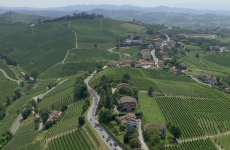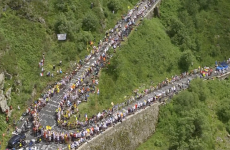Description
July 14, 2024
111th Tour de France 2024 🇫🇷 (2.UWT) ME – Stage 15 – Loudenvielle – Plateau de Beille : 197,7 km
The 111th edition of the Tour de France starts in Florence,
Show more...
July 14, 2024
111th Tour de France 2024 🇫🇷 (2.UWT) ME – Stage 15 – Loudenvielle – Plateau de Beille : 197,7 km
The 111th edition of the Tour de France starts in Florence, Italy, on Saturday, June 29 and ends three weeks later in Nice on Sunday, July 21. It is the first time the Tour starts in Italy. The Tour de France will not finish in Paris as it usually does. Instead, the finish is in Nice to avoid the preparations for the 2024 Olympics Games, which begin just a week later in Paris. The 2024 Tour de France route is 3,492km long with some 52,320 metres of overall elevation, passing through four nations – Italy, San Marino, France, and Monaco. It features two individual time trials for a total of 59km, four mountain-top finishes, a series of gravel sections on stage 9, and a final hilly time trial to Nice.
If there was any doubt that Tadej Pogačar (UAE Team Emirates) was the strongest climber at the 2024 Tour de France, he extinguished them on stage 15 as he landed a repeat blow to GC rival Jonas Vingegaard (Visma-Lease a Bike), taking back-to-back stunning solo victories to close out the second week on the slopes up the Plateau de Beille.
Vingegaard led for much of the 15.8km climb after putting his Visma teammates to work throughout the breathless 197.7km stage and attacking 10.5km from the crest. But Pogačar showed no signs of weakness under the Dane’s pressure, landing what looked like a knockout punch in the fight for the maillot jaune with a 5.4km counterattack and charge to the summit.
As the race leader exploded away again, he stamped his authority over Vingegaard, the man who has beat him in the past two Tours, pushing every ounce of energy out in the run for the line to win with a gap of 1:08. With the second week coming to a close today, they are separated by a large but not insurmountable 3:09.
Third place Remco Evenepoel (Soudal-QuickStep) tried his best to tempo back to the two leaders on the climb but with nearly 5000 metres of elevation gain and over five hours of all-out racing in the legs, the gaps were huge. The Belgian finished third but 2:51 down on Pogačar at the line.
The Plateau de Beille used to be known as a climb that predicts the winner of the Tour, having first been used in 1998 when it was won by a certain Marco Pantani. The controversial Italian great is who Pogačar is trying to emulate in 2024 as the last rider to complete the elusive Giro-Tour double in 98’, with today’s win bringing the Slovenian ever closer to that historic feat.
“I would never imagine this outcome after the second week in the beginning so I’m super happy with my shape. Also, it was super hot and it was a really hard day. Usually, I always struggle with the heat and today, the team did a super good job cooling me down and it was an incredible day,” said Pogačar, before describing how the final battle with Vingegaard played out.
“[Visma] did decide to control today and make a hard pace on the climbs. But I was never worried and I just kept myself cool and hydrating and eating enough.
“So when we came to the bottom of the last climb, I was on the limit a bit when Jonas tried to drop me but I could see he was also starting to suffer. When he tried to drop me the last time, I saw he did not have the legs to go to the top so I tried with my own but it was super tough in the final.”
Pogačar hasn’t won the Tour since 2021 when he beat Vingegaard to second, with the Dane besting him by 7:29 overall last year and 2:43 in 2022. In 2024, however, it looks like it will be Pogačar’s year again.
“Now it’s really looking good. I was already saying this when it was 1:14 and now it’s a really good, comfortable lead,” he said. “We just need to keep focused these last six days and keep this mentality.”
HOW IT UNFOLDED
As the second week was drawing to a close, another brutal day in the Pyrenees awaited the Tour de France peloton and not only was there almost 5000m of elevation and 197.7km in the mountains to come, but it was also Bastille Day.
Le 14-Juillet brings an obligation for French riders to attack at the Tour as they try to win the famous Tour stage on the country’s national day for the first time since Warren Barguil in 2017. And attack they did, with David Gaudu (Groupama-FDJ) and Romain Bardet (DSM-Firmenich PostNL) among the most active from kilometre zero as the Col du Peyresourde opened up racing on stage 15.
Heading uphill right from the flag on a cat.1 climb saw many riders struggling to hold on and dropping under the pressure, as UAE Team Emirates worked to keep a group of the two Frenchman and Oier Lazkano (Movistar) close at just 20 seconds over the top.
Things came back together in the valley but it wasn’t long until the next move was getting up the road and this time it was a huge one, comprised of 21 riders: Michael Matthews (Jayco AlUla), Michał Kwiatkowski (Ineos Grenadiers), Julien Bernard (Lidl-Trek), Nico Denz, Bob Jungels, Jai Hindley (Red Bull-Bora-Hansgrohe), Lenny Martinez (Groupama-FDJ), Rui Costa (EF Education-EasyPost), Nans Peters (Decathlon AG2R La Mondiale), Jakob Fuglsang (Israel-Premier Tech), Guillaume Martin (Cofidis), Enric Mas, Alex Aranburu, Davide Formolo, Gregor Mühlberger (Movistar), Louis Meintjes, Biniam Girmay (Intermarché-Wanty), Magnus Cort, Tobias Halland Johannessen (Uno X-Mobility), Mathieu Burgaudeau and Jordat Jegat (TotalEnergies).
This large group would work well until the intermediate sprint in Marignac, where Girmay was led out to take the maximum 20 points and all but wrap up the green jersey. He was later relegated for deviating into the path of Matthews in his sprint but that competition still looks sewn up.
DSM-Firmenich PostNL and EF Education-EasyPost had kept the gap tight around one minute from the large breakaway, allowing the likes of Bardet and Carapaz to try and bridge to the leaders on the 9.3-kilometre Col de Menté climb.
Initially, the break started splintering and thinning down under the pressure of Red Bull-Bora-Hansgrohe and Movistar who were working most in the big group. But as riders fell away, those behind who missed it had a chance to bridge across and make it 15 riders in front when they reached the top of the next climb – the Col de Portet-d’Aspet.
Javier Romo (Movistar), Carapaz, Aranburu, Simon Yates (Jayco AlUla), Laurens De Plus (Ineos Grenadiers), Matteo Sobrero (Red Bull-Bora-Hansgrohe), Hindley, ben Healy (EF Education-EasyPost), Fuglsang, Martin, Mas, Meintjes, Oscar Onley (DSM-Firmenich PostNL) and Johannessen made it over with just over a minute lead on the Visma-Lease a Bike-led peloton.
It became a battle between Red Bull and Visma on the valley roads that followed the descent, with Jungels doing much of the work for Hindley. Once the infamous Portet-d’Aspet descent was navigated safely and the lovely memorial to Fabio Casartelli was passed, the gap finally began to go out to those in the breakaway.
Visma still led the way but let off from applying the pressure, allowing the break’s advantage to balloon out on the 60km approach to the Col d’Agnes to over 3:30.
The make-up of the break then changed significantly when they hit the penultimate classified climb of the day, as Red Bull-Bora-Hansgrohe continued their strong tactical display with 73.6km to go, accelerating with their three escapees and making a split.
Along with Movistar, they formed a new six-man group before Healy bridged across on his own with a powerful surge, making it seven in front – Jungels, De Plus, Hindley, Healy, Sobrero, Mas and Romo, as the last French hopes dropped out of contention.
But soon the better climbers showed themselves as Hindley hit the front off the back of his teammates’ great work.
Only Mas and De Plus could follow the rider from Perth, with Carapaz launching a move to make the junction behind and being helped by Healy to successfully make contact 62km from the finish.
An uncategorised climb off the descent of the Col d’Agnes then allowed Johannessen to make it five riders in front on the approach towards the final, brutal climb.
Visma continued to pace towards the foot of the climb through Kelderman, with only him and Jorgenson left for Vingegaard, suggesting that the big attack from the defending champion wouldn’t take long to come once they hit the 15.8km beast of a climb.
The break’s advantage had stabilised around the 2:20 mark, however, the peloton was flying behind them under the pressure now of Vingegaard’s final teammate Jorgenson. Quickly, the American had the deficit at 1:45 barely a kilometre into the summit finish and the men in front’s chances were looking slim.
Such was Visma’s destruction that even Almeida dropped, lessening Pogačar’s help behind, with Yates still there alongside only the best GC riders. Soon Giulio Ciccone (Lidl-Trek) and Felix Gall (Decathlon AG2R La Mondiale) were done too with over 13km left to climb
Hindley and Carapaz tried to launch moves out of the break but their advantage kept ticking in the wrong direction under Jorgenson’s infernal pace, with Vingegaard looking excellent in the polka-dot jersey. This theme continued in the break with several random attacks coming on the lower slopes as the GC group closed in until Mas, Johannessen and Carapaz found some breathing room.
As Carapaz finally got solo as he wanted with 10.6km to go, Jorgenson continued his assault on the peloton as he dropped Carlos Rodríguez (Ineos) and Santiago Buitrago (Bahrain Victorious) but the Ecuadorian’s hopes of the win were soon gone as Vingegaard made his move.
The Dane exploded out of the group 10km from the top of the climb, with Pogačar able to follow and they had reeled back the remnants of the break just 700 metres later. Carapaz managed to follow as Mas fell away but Vingegaard kept up his effort onto the steepest sections and the Olympic champion soon fell away.
Results :








































Please, upload all the races in HD quality 🙂